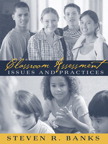Classroom Assessment Issues and Practices
By Murray Bourne, 26 Jun 2005

Steven R. Banks, Allyn & Bacon, 2005.
Book review/summary
What is assessment for? I have been doing exams all my life - either writing them as a student, or marking them as a teacher. Frankly, I'm not sure what is worse. Exams are a good example of the many great disconnects in education. That is, they don't demonstrate what students know very well - they seem to to be more interested in what students don't know.
In the USA, a big driver of reform is Bush's No Child Left Behind policy (2001). All schools need to do annual assessments are are concerned about accountability and comparisons between schools. Other issues are the accrediation of teachers and also the inclusion of students with special needs into mainstream education.
These issues are the motivation for the book Classroom Assessment Issues and Practices.
I like the way each chapter of the book begins with a case study. The first one raises the issue of how important the nationwide accountability examinations are to administrators - and how confusing this can be for first-time teachers. What is the scope for developing interesting assessments, when the government is calling the shots?
There is an emphasis in the book on alternative asssessments - a memorable one being the peer assessment game, where students assess each other on certain positive classroom behaviours.
The Buckley Amendment is something that much of Asia would never adopt willingly. This 1974 law prohibits the disclosure of academic records to anyone other than the student or the parents. The outcome of this is that it reduces competition in the classroom & encourages a cooperative atmosphere. Many Asian school systems thrive on competitive structures... However, what I find interesting is that one aspect of the No Child Left Behind policy means that students may opt out of a "failing school" and go to a "passing school" in the same district. Is that competitive pressure, or what?
Another interesting aspect of No Child Left Behind is the requirement that all children must be able to read by the end of 3rd grade. This is good - but how is "read" defined and assessed? Do the assessors have a conflict of interest, in that the school must "pass" so the temptation is to "pass" every kid at that level?
The worry for all teachers under such a system is - what if my students are weak to start with (for all sorts of reasons - socio-economic background, limited educational opportunities, home background, disabilities) and it is such a long journey for them to reach the required standards. Why am I made accoountable for society's failings?
Quality of Teachers
There is also an emphasis in the policy on the quality of teachers entering the profession - but the problem here is that so few people want to become teachers and so there are critical shortages - especially among male teachers and in the mathematics & science areas.
One of the case studies (p46) delightfully points out a common dilemma. Students are in your class, having met certain pre-requisites. But as soon as you assume those students know that stuff, it will always lead to disaster. The best assumption is that they know about 20% of what they were supposed to know from last semester...
Revised Bloom
The book outlines Anderson and Krathwohl's 2001 Revision of Bloom's Taxonomy. This gives educators an even better framework for designing assessments that elicit higher-level thinking.
Other Issues
Other issues raised in the book include:
- Assessments should allow for diversity and gender, esteem level, cultural influences and langauage abilities.
- Get students to complete reflective logs, portfolios and self assessments.
- Different types of tests and when to give them
- When designing learning experiences, how can we know students are learning? What are they learning?
- How to deal with parents (and education systems?) who believe their child deserves to pass
- Grading
- Standardised tests, including the racial abuses of the IQ test
- Testing for at-risk students
- The key connection between motivation and assessment
- Aseessment of teachers
The book has plenty of case studies, examples and "Teacher Applications" that make it an interesting read.
I recommend this book to any educator, whether they are at the beginning of their career or whether they are seasoned practitioners. After all, the assessment process affects the lives of all of our students...
Be the first to comment below.